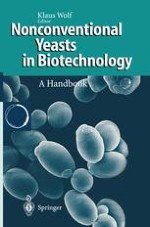1996 | OriginalPaper | Chapter
Pichia pastoris
Authors : Koti Sreekrishna, Keith E. Kropp
Published in: Nonconventional Yeasts in Biotechnology
Publisher: Springer Berlin Heidelberg
Included in: Professional Book Archive
Activate our intelligent search to find suitable subject content or patents.
Select sections of text to find matching patents with Artificial Intelligence. powered by
Select sections of text to find additional relevant content using AI-assisted search. powered by
Interest in the study of nonconventional yeasts (yeasts other than Saccharomyces cerevisiae and Schizosaccharomyces pombe) has increased dramatically in the past few years (Reiser et al. 1990). One such category is methylotrophic yeasts (Wegner and Harder 1986; Harder et al. 1986), e.g., Pichia pastoris, Hansanula polymorpha, Candida boidinii, etc. Methylotrophic yeasts have the ability to use methanol as a sole source of carbon and energy. Adaptation to growth on methanol is associated with induction of methanol oxidase, MOX (also referred to as alcohol oxidase, AOX), dihydroxy acetone synthase DAS, and several other enzymes involved in methanol metabolism. The most spectacular increase, however, is seen with alcohol oxidase, which is virtually absent in glucose-grown cells, but can account for over 30% of the cell protein in methanol-grown cells. Extensive proliferation of peroxisomes, accounting for over 80% of the cell volume, is also observed in methanol-grown cells (Veenhuis et al. 1983). Due to these characteristics, methylotrophic yeasts have gained the attention of biochemists, molecular biologists, cell biologists, biotechnologists, microbiologists, and chemists in academics and industry.
